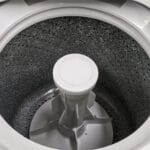Imagine walking into a room, expecting it to be softly illuminated by your motion sensor light, only to find it blinking red instead. You may feel a slight jolt of confusion or even a hint of frustration.
What does this blinking red light mean? Is it a warning, a malfunction, or just a simple signal? This little red light might be trying to tell you something crucial, and understanding it could save you time and energy. You’ll discover why your motion sensor light is blinking red and learn how to solve this mystery.
So, get ready to shed light on this common issue and ensure your home stays as safe and efficient as you need it to be.

Credit: www.youtube.com
Common Causes Of Red Blinking
Have you ever noticed your motion sensor light blinking red? This can be both confusing and frustrating, especially if you’re unsure of what’s causing it. Red blinking typically indicates an issue that needs attention. Understanding the common causes can help you troubleshoot effectively and restore your light’s function.
Battery Issues
One of the most frequent reasons for red blinking is battery problems. Low battery power can trigger a warning sign on your sensor. Have you recently checked the battery status? If not, it might be time to replace them. A fresh set of batteries can sometimes solve the problem immediately.
In some cases, batteries might be incorrectly installed. Double-check their positioning. Make sure they are inserted correctly according to the polarity markings.
Sensor Malfunctions
Sensor malfunctions are another common culprit. Sensors can occasionally glitch, especially if they’ve been exposed to extreme weather conditions. Is your sensor located outdoors? If yes, it might be worth inspecting it for any visible damage.
Sometimes, cleaning the sensor with a soft cloth can resolve minor malfunctions. Dust and debris can interfere with sensor accuracy, causing it to blink red unnecessarily.
Environmental Interferences
Environmental factors can also impact sensor performance. Have you ever noticed your sensor blinking after a storm? Strong winds or vibrations can sometimes disturb the unit. Make sure your sensor is securely mounted.
Additionally, nearby electronic devices might emit signals that interfere with the sensor’s operation. Consider changing the location of your motion sensor light if you suspect interference.
Could it be that your motion sensor light is simply trying to communicate a minor issue or adjustment needed? With these insights, you’re better equipped to diagnose and resolve the blinking red light efficiently.
Diagnosing The Problem
Motion sensor lights are a fantastic addition to any home, offering security and convenience. However, a blinking red light can be a cause for concern. It might seem like a minor issue, but understanding why this happens can save you from bigger problems down the line. Let’s dive into diagnosing the problem to ensure your motion sensor light is functioning optimally.
Checking Battery Levels
First things first, check the battery levels. Low batteries can often cause your motion sensor light to blink red. This might seem obvious, but it’s an easy fix that many overlook. A quick battery replacement could resolve the issue instantly.
If your light is battery-powered, consider if it’s been a while since you last changed them. Are the batteries fresh? If they’re rechargeable, ensure they’re fully charged. Always have spare batteries on hand to avoid unnecessary frustration.
Inspecting Sensor Connections
Next, inspect the sensor connections. Loose or corroded connections can disrupt the functionality of your motion sensor light. It’s like having a phone with a bad connection; it just won’t work right.
Gently check if all wires and connections are secure. You might need to tighten screws or replace corroded parts. Examine the area for any signs of wear and tear. This often goes unnoticed and can be the culprit behind the blinking red light.
Assessing Surrounding Conditions
Consider the conditions around your motion sensor. Environmental factors can impact its performance. Have you moved any furniture or objects around it recently? Sometimes, the sensor’s view can be obstructed, causing it to malfunction.
Also, think about the weather. Extreme temperatures or humidity can affect sensor sensitivity. Are there any interference sources nearby, like a direct light source? Adjustments in the surroundings might be all it takes to stop that annoying red blink.
It’s crucial to get to the root of the problem rather than just applying a quick fix. By thoroughly diagnosing these aspects, you ensure your motion sensor light keeps your home safe and sound. What other potential issues have you encountered with your motion sensors?
Simple Fixes To Try
Motion sensor lights are handy for home security. But a blinking red light can be annoying. This might happen due to a few common issues. You can try some simple fixes before calling a professional. These solutions are easy and often solve the problem quickly.
Replacing Batteries
Old batteries can cause the light to blink. Check the battery compartment. Replace them if needed. Ensure the new batteries are fresh and properly inserted. This simple change often resolves the blinking issue.
Cleaning The Sensor
Dirt and dust can block the sensor. Use a soft cloth to wipe it clean. Be gentle to avoid damage. A clean sensor works better and may stop the blinking.
Adjusting Sensitivity Settings
The sensor’s sensitivity might be too high. This can cause it to blink. Look for a small dial or switch on the device. Lower the sensitivity slightly. Test the light to see if the blinking stops.

Credit: www.reddit.com
Advanced Troubleshooting
Experiencing issues with your motion sensor light blinking red? Advanced troubleshooting can help resolve this problem. This guide offers practical solutions to restore your sensor light’s functionality. Follow these steps to ensure your device operates smoothly.
Resetting The Device
Resetting the device is a simple first step. Unplug the motion sensor light. Wait for about 30 seconds. Then, plug it back in. This process can fix minor glitches. Check if the red blinking stops. If not, proceed to the next step.
Updating Firmware
Firmware updates can improve device performance. Visit the manufacturer’s website. Look for firmware updates specific to your model. Follow the instructions to update your device. Updated firmware often resolves software-related issues. Ensure your device stays up-to-date for optimal performance.
Consulting Manufacturer Support
Still facing issues? It’s time to contact manufacturer support. They offer expert advice tailored to your device. Reach out via phone or email. Provide them with your device’s details. They can guide you through advanced troubleshooting steps. Their expertise can help solve persistent problems effectively.
Preventive Measures
A blinking red motion sensor light may signal low battery or sensor obstruction. Regularly check and replace batteries to ensure functionality. Keep the sensor clean and free from obstructions for optimal performance.
Preventive measures can significantly reduce the likelihood of your motion sensor light blinking red unexpectedly. Taking the right steps not only ensures functionality but also extends the lifespan of your device. Let’s delve into some practical strategies you can use to maintain your motion sensor lights effectively.Regular Maintenance Checks
Frequent maintenance checks are crucial for keeping your motion sensor lights in perfect working condition. Ensure that you clean the sensor lens regularly as dust and dirt can obstruct its functionality. Also, inspect the wiring and connections for any signs of wear or damage. Consider setting a reminder on your phone or calendar to perform these checks every couple of months. This habit ensures that small issues are caught and resolved before they escalate. Have you ever thought about how a simple wipe can prevent a malfunction? It’s often the little things that make a big difference in maintaining your devices.Optimal Installation Practices
Installing your motion sensor lights correctly is vital. Position the sensor at the right height to ensure optimal coverage and avoid false alarms. Typically, placing them around 6 to 10 feet above ground is ideal. Avoid areas with high traffic from non-human entities, like swaying trees or busy roads, as these can trigger false alerts. During my last installation, I found that adjusting the angle slightly reduced unnecessary triggers. Sometimes, a small tweak can save you hours of troubleshooting.Avoiding Common Mistakes
Common mistakes during installation or maintenance can lead to the red blinking light issue. Ensure that you do not overload the circuit by connecting too many lights to a single sensor. Each sensor has a specific capacity, and exceeding it can cause malfunctions. Don’t ignore the manufacturer’s instructions. They provide insights tailored to your specific model that can prevent issues from arising. Do you often skip the manual? It might be time to give it a second glance; it could save you from a blinking red light and a lot of hassle. These preventive measures, when followed diligently, can ensure that your motion sensor light operates smoothly, without the dreaded red blink. Implement them today and enjoy uninterrupted illumination.
Credit: www.amazon.com
Frequently Asked Questions
What Causes Motion Sensor Light To Blink Red?
A blinking red light often indicates a low battery or sensor malfunction. Check the power source first.
How Can I Fix A Blinking Red Motion Sensor Light?
Start by replacing the batteries. If it continues, inspect the sensor and settings for any issues.
Is A Blinking Red Light A Sign Of Danger?
Not usually. It often signals a technical issue rather than a security threat.
Can Weather Affect Motion Sensor Lights?
Yes, extreme weather can disrupt sensor functionality. Ensure the light is weatherproof and properly installed.
How Do I Reset My Motion Sensor Light?
Turn off the power for a few minutes, then switch it back on. This often resets the system.
Conclusion
Red blinking lights can be worrying. But solutions exist. Check the manual first. Inspect the sensor area for dirt or damage. Sometimes, batteries need a change. Resetting the device might help too. If the problem persists, consider professional assistance. Regular maintenance prevents future issues.
Keep your sensor clean and updated. A reliable motion sensor light ensures safety. Always test after any adjustments. Your peace of mind matters. Stay alert to unusual signals. Take action promptly for optimal performance.




